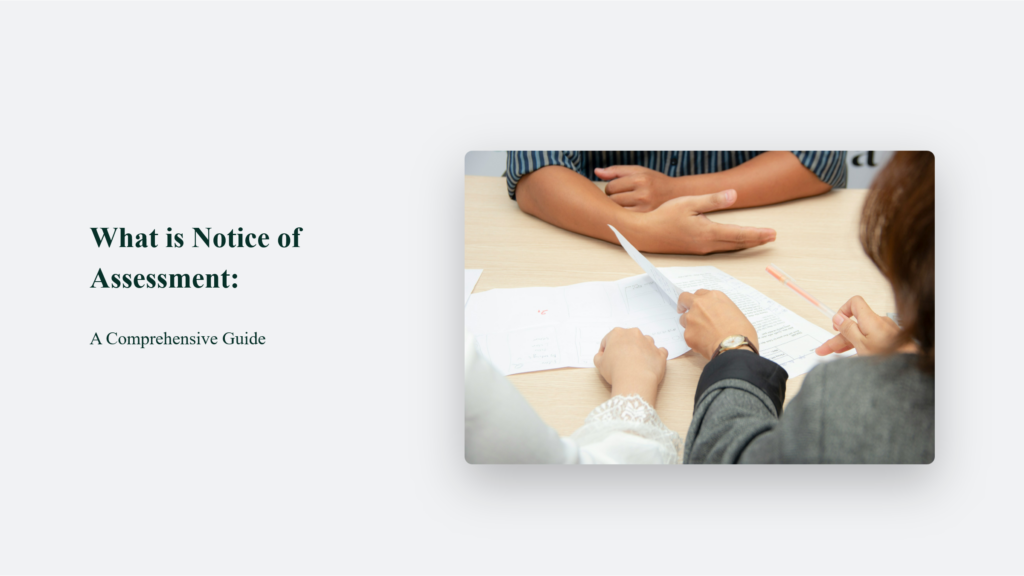In the realm of taxation, receiving a notice of assessment (NOA) can evoke a mix of emotions, from relief to confusion. This crucial document, a bridge between taxpayers and the tax authorities, is a final statement on your tax situation for a given year. Yet, for many, its intricacies remain shrouded in mystery.
Let’s embark on a journey to demystify what is Notice of Assessment, transforming it from a source of perplexity to a beacon of clarity.

What is Notice of Assessment?
At its core, the Notice of Assessment is the taxman’s reply to your annual tax return. It’s an official statement detailing how much tax you owe, your refund amount (if applicable), and other vital tax-related information. Imagine it as the closing chapter of your yearly tax saga, providing a snapshot of your financial dance with the government.
Key Insights into Your Notice of Assessment:
Understanding the Notice of Assessment (NOA) is crucial for effective financial planning and tax management. The NOA, a cornerstone document issued by the tax authority after submitting your tax return, serves multiple purposes. Beyond merely indicating the amount of tax you owe or the refund you are entitled to, it offers valuable insights and information for future financial decisions. Here are the key insights into how the NOA can be a pivotal tool in your financial toolkit:
A Reflection of Your Tax Return
The Notice of Assessment is a direct response to your submitted tax return. Whether you choose the modern convenience of electronic filing or the traditional method of paper returns, the NOA signifies the culmination of your annual tax filing process. It is effectively the tax authority’s way of saying, “We’ve reviewed your submission, and here’s what we think”:
- Electronic Filing: If you filed your taxes electronically, the turnaround time for receiving your NOA is notably swift, usually around two weeks. This efficiency benefits those eager to confirm their tax situation promptly.
- Paper Filing: Opting for a paper return naturally extends the processing time, leading to a longer wait of up to eight weeks. While less efficient, this method remains vital for individuals who, for various reasons, prefer or require it.
The NOA meticulously reviews the data you submitted, verifying or correcting it as necessary. It’s a critical document that confirms the government’s assessment of your tax obligations or refunds for the year, ensuring that both parties—taxpayer and tax authority—are aligned.
A Tool for Future Planning
Far from being a mere statement of your past fiscal interactions, the Notice of Assessment holds keys to your financial future, particularly in areas like retirement planning and managing specific tax-advantaged plans:
RRSP Contribution Room:
One of the most valuable information the NOA provides is your updated RRSP (Registered Retirement Savings Plan) contribution room. This figure is crucial for planning your retirement savings, as it tells you how much you can contribute in the coming year without facing a penalty for over-contribution.
Understanding your RRSP contribution room allows for strategic financial planning, enabling you to maximise your retirement savings and minimise your tax liability.
Repayment Information for Plans:
The NOA is particularly important for individuals participating in the Home Buyer’s Plan (HBP) or the Lifelong Learning Plan (LLP). It informs you of your repayment obligations for the coming year.
These plans allow Canadians to withdraw from their RRSPs under specific conditions, stipulating that the borrowed amount must be repaid over time. The NOA provides detailed information on how much needs to be repaid and when crucial for maintaining the tax-advantaged status of your RRSP and avoiding potential penalties.
Accessing and Understanding Your Notice of Assessment (NOA)
The Notice of Assessment is a cornerstone document in the realm of personal finance and taxation. It acts as the Canada Revenue Agency’s (CRA) official response to your tax return, detailing your tax situation for the year, including the total income assessed, taxes owed, or the refund you’re entitled to receive. Understanding and accessing your NOA is essential for several reasons:
- Verification: The NOA confirms the accuracy of your tax return from the CRA’s perspective, allowing you to verify that your income, deductions, and credits have been correctly applied and calculated.
- Record of Assessment: It records your tax obligations and entitlements for the year, including any changes to your RRSP contribution room or obligations under programs like the Home Buyer’s Plan or Lifelong Learning Plan.
- Financial Planning: By detailing your tax situation, the NOA provides valuable information that can be used for future financial planning, helping you make informed decisions about savings, investments, and other financial strategies.
If your NOA goes missing or you need to reference it, the CRA has made it easy to access this document. You can log into your CRA account online to view or download a copy of your NOA. This digital access ensures that you can always retrieve your NOA when needed, providing a convenient way to stay informed about your tax situation.
The Joy of Tax Refunds: A Silver Lining
The tax refund is often the most anticipated part of the tax season for many taxpayers. It represents a return of overpaid taxes throughout the year, effectively acting as a forced savings plan that pays out once your return is processed. Here are key aspects of tax refunds:
- A Financial Boost: For many, the tax refund provides a timely financial boost, helping to pay off debt, invest, save, or even fund discretionary purchases. It’s a moment of financial reprieve that rewards accurate and timely tax filing.
- Direct Deposit or Cheque: Taxpayers can receive their refunds directly deposited into their bank accounts or as a cheque. Direct deposit is faster and more secure, ensuring the refund is received without the risk of mail delays or loss.
- Incentive for Early Filing: Filing your tax return early can lead to receiving your refund sooner, incentivising taxpayers to get their tax affairs in order well before the deadline.
Maximising Your Understanding and Returns
Understanding your Notice of Assessment and anticipating a tax refund are integral parts of the tax filing process. Here are a few tips to maximise your experience:
- Review Your NOA Carefully: Review your NOA thoroughly to ensure all information is accurate and that you understand your tax situation fully.
- Plan for Your Refund: Consider planning your tax refund to make the most of this financial boon. Whether it’s saving, investing, or paying down debt, having a plan can enhance the impact of your refund.
- Stay Informed: Keep abreast of any changes to tax laws, deductions, and credits that can affect your tax return and potential refund. Staying informed can help you optimise your tax situation and increase the chances of a favourable outcome.
The Bottom Line:
By delving into the nuances of the Notice of Assessment, we shed light on its importance as a summary of your tax situation and as a tool for future financial planning. Whether you’re a seasoned taxpayer or new to the game, understanding your NOA can significantly impact your financial journey, offering insights and opportunities to optimise your tax strategy and enhance your financial well-being.
Frequently Asked Questions:
What if I disagree with my NOA?
You have 90 days from the date of the assessment to file an objection. This is your right to challenge the CRA’s conclusions and present your case.
Can the NOA affect my future tax filings?
Absolutely. It provides valuable information, such as your RRSP contribution room, that can influence your financial decisions and tax strategies for the coming year.
Is it possible to amend information on my NOA?
Yes, if you find discrepancies or errors, you can request an amendment within the stipulated timeframe to ensure your tax records accurately reflect your financial situation.




